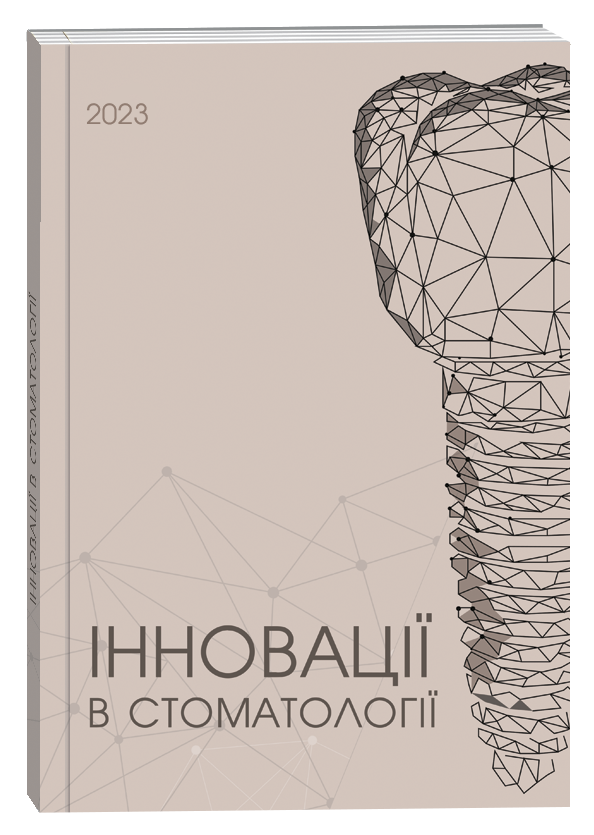THE NEED FOR PROSTHETIC TREATMENT AND PECULIARITIES OF THE CLINICAL AND FUNCTIONAL STATE OF SUPPORTING TEETH IN YOUNG AGED PATIENTS WITH GENERALIZED PERIODONTITIS
DOI:
https://doi.org/10.35220/2523-420X/2023.3.5Keywords:
generalized periodontitis, persons of young age, defects of teeth and dentitions, need for prosthetic treatment, dental prosthetics, dental splinting, computer occlusiography, computer tomographyAbstract
Purpose of the study. To determine the need for prosthetic treatment and peculiarities of the clinical and functional state of supporting teeth in young aged patients with generalized periodontitis. Research methods. The observation included 300 patients of young age with generalized periodontitis who applied for prosthetic dental care. Computer tomography and occlusiography were performed in addition to the clinical study. Scientific novelty. The initial degree of generalized periodontitis was diagnosed in 62.0% of patients, the first degree – in 22.0%, the second degree – in 16.0%; the third grade was not observed. 73.0% of patients had dentition defects: in 70.3% they were small defects and in 29.7% they were middle-sized. According to Kennedy, defects of I class were in 4.0%, class II – in 9.0%, class III – in 81.0%, class IV – in 6.0%. Dentition defects were complicated by deformations in 48.0% of patients. 87.0% of persons needed dental prosthetics: they were 66.0% for dentition defects and 21.0% – for crown defects. Fixed dental splinting was required in 19.0%. The need for the removable designs of splints and dentures was not revealed. At the time of observing, 23.0% of patients had dental prosthetics, in particular with splinting elements, which was characterized by errors in 63.7% of cases. For fixed splinting, which was in 12.0% of patients, fiberglass splints were most often (58.3%). 22.2% of designs were interdental splints and 19.5% were metalceramic splints. In 11.1% of cases of splinting, there was irrational type of teeth immobilization. In 13.9% of patients who used fixed splints, technical inaccuracies of the designs were revealed. According to the results of computer occlusiography, in 100% of patients there was no uniform multiple interdental contact in dynamic occlusion. Centric supracontacts were recorded in 37.0%, eccentric – in 65.0%. In 22.0% of patients, there were hyperbalanced interdental contacts. In 73.0%, an occlusion imbalance was observed. Significant violations of the occlusive load vector were recorded in 24.0%. In areas of occlusive overloading, there was a decrease in the mineral density of the alveolar bone. Conclusions. Among patients with generalized periodontitis of young age, there is the biggest need for fixed prosthetics. The clinical and functional state of supporting teeth should be taken into account when planning prosthetic treatment, the purpose of which is to normalize occlusive contacts and splinting of moving teeth.
References
Kwon, T., Lamster, I. B., & Levin, L. (2021). Current concepts in the management of periodontitis. International dental journal, 71 (6), 462–476. https://doi.org/10.1111/idj.12630
Mills, A., & Levin, L. (2022). Inequities in periodontal disease prevalence, prevention, and management. Quintessence international (Berlin, Germany: 1985), 53 (2), 122–132. https://doi.org/10.3290/j.qi.b1763677
Sanz, M., Herrera, D., Kebschull, M., Chapple, I., Jepsen, S., Beglundh, T., Sculean, A., Tonetti, M. S., & EFP Workshop Participants and Methodological Consultants (2020). Treatment of stage I-III periodontitis. The EFP S3 level clinical practice guideline. Journal of clinical periodontology, 47 Suppl 22, 4–60.
Scannapieco, F. A., & Gershovich, E. (2020). The prevention of periodontal disease. An overview. Periodontology 2000, 84 (1), 9–13. https://doi.org/10.1111/prd.12330
Cortellini, P., Stalpers, G., Mollo, A., & Tonetti, M. S. (2020). Periodontal regeneration versus extraction and dental implant or prosthetic replacement of teeth severely compromised by attachment loss to the apex: A randomized controlled clinical trial reporting 10-year outcomes, survival analysis and mean cumulative cost of recurrence. Journal of clinical periodontology, 47(6), 768–776. https://doi.org/10.1111/jcpe.13289
Carra, M. C., Rangé, H., Swerts, P. J., Tuand, K., Vandamme, K., & Bouchard, P. (2022). Effectiveness of implant-supported fixed partial denture in patients with history of periodontitis: A systematic review and meta-analysis. Journal of clinical periodontology, 49 Suppl 24, 208–223. https://doi.org/10.1111/jcpe.13481
Clark, D., & Levin, L. (2019). In the dental implant era, why do we still bother saving teeth? Dental traumatology: official publication of International Association for Dental Traumatology, 35 (6), 368–375. https://doi.org/10.1111/edt.12492
Kumar S. (2019). Evidence-based update on diagnosis and management of gingivitis and periodontitis. Dental clinics of North America, 63 (1), 69–81. https://doi.org/10.1016/j.cden.2018.08.005
Kierce, E. A., & Kolts, R. J. (2023). Improving periodontal disease management with artificial intelligence. Compendium of continuing education in dentistry (Jamesburg, N. J.: 1995), 44 (6), e1–e4.
Curtis, D. A., Lin, G. H., Rajendran, Y., Gessese, T., Suryadevara, J., & Kapila, Y. L. (2021). Treatment planning considerations in the older adult with periodontal disease. Periodontology 2000, 87 (1), 157–165. https://doi.org/10.1111/prd.12383
Laudenbach, J. M., & Kumar, S. S. (2020). Common dental and periodontal diseases. Dermatologic clinics, 38 (4), 413–420. https://doi.org/10.1016/j.det.2020.05.002
Srimaneepong, V., Heboyan, A., Zafar, M. S., Khurshid, Z., Marya, A., Fernandes, G. V. O., & Rokaya, D. (2022). Fixed prosthetic restorations and periodontal health: A narrative review. Journal of functional biomaterials, 13 (1), 15. https://doi.org/10.3390/jfb13010015
Ercoli, C., Tarnow, D., Poggio, C. E., Tsigarida, A., Ferrari, M., Caton, J. G., & Chochlidakis, K. (2021). The relationships between tooth-supported fixed dental prostheses and restorations and the periodontium. Journal of prosthodontics: official journal of the American College of Prosthodontists, 30 (4), 305–317. https://doi.org/10.1111/ jopr.13292
Ercoli, C., & Caton, J. G. (2018). Dental prostheses and tooth-related factors. Journal of periodontology, 89 Suppl 1, S223–S236. https://doi.org/10.1002/JPER.16-0569
Cambiaghi, L., de Azevedo-Silva, L. J., Campos Costa, M. S., da Silva Costa, S. M., & de Almeida, A. L. P. F. (2023). Is Periodontal and peri-implant disease associated with fixed partial denture use? A 25-year prospective case series. The European journal of prosthodontics and restorative dentistry, 10.1922/EJPRD_2542Cambiaghi09. Advance online publication. https://doi.org/10.1922/EJPRD_2542Cambiaghi09
Gotfredsen, K., Rimborg, S., & Stavropoulos, A. (2022). Efficacy and risks of removable partial prosthesis in periodontitis patients: A systematic review. Journal of clinical periodontology, 49 Suppl 24, 167–181. https://doi.org/10.1111/jcpe.13519
Al-Nasser, L., & Lamster, I. B. (2020). Prevention and management of periodontal diseases and dental caries in the older adults. Periodontology 2000, 84 (1), 69–83. https://doi.org/10.1111/prd.12338








